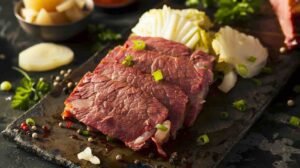Au Jus Recipe: A Culinary Legacy
The French Culinary Tradition
Beginnings in France
The concept of au jus recipe originates from the traditional French approach to cooking meat, where great importance is placed on preserving and utilizing all parts of the meat, including the juices. In France, au jus is not just a by-product of cooking but a cherished component that enhances the flavour of meat dishes.
Au Jus, meaning “with juice” in French, is a technique that enhances meat dishes by serving them with their natural juices. This method not only boosts flavour but also respects the authenticity of the ingredients, making Au Jus a revered practice in culinary traditions across the globe.
Evolution and Techniques
Over time, French chefs have refined the process of making au jus, developing techniques to maximize the flavour. This includes careful roasting to ensure that the juices are flavourful and using deglazing methods, where a liquid (often wine or broth) is added to a hot pan to lift the caramelized bits of meat from the bottom, creating a rich base for the au jus.
Regional Variations in France
Different regions in France have their own variations of au jus, influenced by local ingredients and culinary traditions. For example, in wine-producing regions, it’s common to find au jus made with a local wine, adding a unique regional flavor to the dish.
Traditional Applications
Roast Meats
Traditionally, au jus is served with roast meats such as beef, lamb, or poultry. It is often presented on the side or lightly drizzled over the meat to enhance its natural flavours without overpowering them.
French Dip Sandwiches
Though not a traditional French dish, the French Dip Sandwich, an American invention, showcases the popularity of au jus beyond France. This sandwich consists of thinly sliced roast beef on a baguette, often served with a side of au jus for dipping.
Modern Adaptations Across Cultures
Global Influence
As French cuisine has influenced global culinary practices, au jus has been adapted by different cultures. Chefs around the world have incorporated au jus into their dishes, sometimes adding local ingredients or using alternative cooking techniques to put their own spin on this classic.
Fusion Dishes
In modern cooking, au jus is often used in fusion dishes, combining elements from various culinary traditions. For example, an Asian-inspired au jus might include ingredients like soy sauce or ginger, adding a new dimension to the traditional flavour.
The Perfect Au Jus Recipe
Creating an exceptional Au Jus involves a blend of simplicity and taste. The essential Au Jus recipe includes beef drippings, broth, and a hint of red wine or Worcestershire sauce, simmered to produce a flavourful gravy that complements the main dish.
Advanced Flavour Enhancement Techniques for Au Jus Recipe
Au jus, the rich gravy made from the juices of cooked meat, can be elevated from its simple origins to a complex and sophisticated sauce. By incorporating advanced techniques and a variety of ingredients, you can deepen the flavors and create a more nuanced and satisfying accompaniment to meat dishes.
Incorporating Aromatic Herbs
Selecting the Right Herbs
Herbs such as rosemary, thyme, and sage are excellent for adding depth to au jus. These herbs complement the natural flavors of the meat and bring a fresh, aromatic quality to the sauce.
Technique
To infuse the au jus with herbal notes, add whole sprigs or leaves during the cooking process. This allows the essential oils and flavors to meld with the meat juices. Be sure to remove the herbs before serving to avoid overpowering the sauce.
Utilizing Wine Reductions in the Au Jus Recipe
Choosing the Wine
The choice of wine can greatly affect the flavor of your au jus. Red wines are typically used for beef au jus, adding a robust and slightly acidic note. For lighter meats like poultry, a white wine can introduce a subtle, fruity complexity.
Reduction Process
To concentrate the flavors, simmer the wine in a pan until it reduces by half before adding it to the meat juices. This process intensifies the wine’s characteristics, adding a rich layer to the au jus.
Incorporating Umami-Rich Ingredients
Umami Boosters
Ingredients like mushrooms, anchovies, or a dash of soy sauce are packed with umami, the savory fifth taste. These can add a profound depth and richness to the au jus.
Integration Tips
Finely chop mushrooms or anchovies and sauté them before adding to the au jus to ensure they are well incorporated. For soy sauce, a small amount goes a long way; add gradually and taste to avoid overpowering the sauce.
Achieving Balance
Balancing Flavors
The key to a great au jus is balance. Ensure that no single ingredient dominates. Adjust the seasoning with salt and pepper, and consider a splash of acidity, like lemon juice or vinegar, to brighten the flavors.
Consistency Matters
The texture of the au jus is just as important as the taste. If the sauce is too thin, a light simmer can help reduce it to the desired consistency. Be mindful not to over-reduce, as this can concentrate the flavors too much.
Practical Tips for Perfection
- Taste as You Go: Continuously taste and adjust the seasoning of your au jus. This will help you achieve the perfect balance of flavors.
- Strain for Smoothness: For a silky-smooth sauce, strain the au jus before serving to remove any solids.
- Experiment with Ingredients: Don’t be afraid to experiment with different herbs, wines, and umami-rich ingredients to find the perfect combination that suits your taste.
By employing these advanced techniques and being mindful of the balance of flavors, you can elevate your au jus to a gourmet level, adding an exquisite touch to your dishes.
Ingredients for Au Jus Recipe
– 4 tablespoons butter or beef drippings
– 2 tablespoons all-purpose flour (with alternatives for dietary needs)
– ¼ cup red wine or beef broth
– 2 cups beef broth
– 1 tablespoon Worcestershire sauce
– Salt and pepper, to taste
Pairing Au Jus with Diverse Cuisines
Au jus, traditionally paired with roasted meats, is a versatile sauce that can enhance a wide array of dishes across various cuisines, including vegetarian options and fusion creations. By adjusting its preparation and ingredients, au jus can be tailored to complement different main components and culinary traditions.
Pairings with Different Proteins
Beef and Lamb
For robust meats like beef and lamb, a classic au jus with red wine reduction and herbs like rosemary and thyme works well. The rich flavors of the meat are complemented by the deep, aromatic qualities of the sauce.
Poultry and Pork
When serving with lighter meats such as poultry and pork, consider using white wine or apple cider in your au jus and incorporating milder herbs like sage or tarragon. This creates a lighter, more delicate sauce that enhances without overpowering the meat.
Fish and Seafood
For fish and seafood dishes, a minimalist approach works best. A light au jus made with white wine, lemon zest, and dill can add a subtle, refreshing touch to the delicate flavors of seafood.
Vegetarian Pairings
Grilled Vegetables
Au jus can be adapted for vegetarian dishes by using vegetable broth as a base and adding umami-rich ingredients like mushrooms or a dash of soy sauce. Drizzle over grilled vegetables like eggplant or portobello mushrooms for a savory boost.
Tofu and Tempeh
For protein-rich vegetarian options like tofu and tempeh, a soy-based au jus with ginger and garlic can add depth and complexity. This Asian-inspired twist pairs well with dishes that have a subtle flavor profile, allowing the au jus to shine.
Fusion Dish Pairings of Au Jus Recipe
Asian Fusion
For Asian fusion dishes, integrate ingredients like star anise, soy sauce, and rice wine vinegar into your au jus. This version complements dishes like bao buns filled with slow-cooked meats or grilled tofu.
Mediterranean Fusion
For a Mediterranean twist, incorporate sun-dried tomatoes, olives, and a hint of citrus into the au jus. This variation pairs beautifully with grilled fish, lamb, or a medley of roasted Mediterranean vegetables.
Latin American Fusion
Create a Latin American-inspired au jus with ingredients like smoked paprika, cumin, and a splash of lime. This vibrant sauce is perfect for drizzling over grilled meats or plant-based proteins served with rice and beans.
Adjusting the Au Jus Recipe for Different Cuisines
To ensure the au jus complements the main ingredients and overall flavour profile of a dish, consider the following adjustments:
- Spice Level: Adjust the heat by adding or reducing spicy elements like chili flakes or fresh peppers to match the cuisine’s spice tolerance.
- Acidity: Balance the richness of au jus with acidity. For dishes with heavier flavours, a touch of vinegar or citrus can lighten the sauce.
- Herbs and Spices: Select herbs and spices that align with the dish’s culinary roots. For example, use cilantro and lime for a Mexican-inspired au jus or rosemary and garlic for an Italian twist.
By thoughtfully pairing and adjusting au jus, you can enhance a wide variety of dishes, adding an extra layer of flavor that ties the components together harmoniously. Whether it’s a meat-centric feast, a vegetarian delight, or a bold fusion experiment, au jus can be your secret weapon in elevating the dining experience.
Crafting Your Au Jus Recipe
- Begin with the Base: Melt butter or heat drippings in a saucepan over medium-high heat.
- Making the Roux: Add flour to the melted butter or drippings, whisking to form a smooth base.
- Adding Liquids: Stir in the red wine or beef broth, then gradually add the beef broth, whisking continuously.
- Enhancing Flavour: Mix in the Worcestershire sauce and bring the Au Jus to a boil, then simmer until slightly thickened. Season with salt and pepper.

Adapting the Au Jus Recipe
The Au Jus recipe is versatile, allowing for variations with or without beef drippings. It can be adapted for gluten-free or paleo diets by substituting the flour with a suitable alternative.
Nutritional Aspects of Au Jus
Au Jus is not just flavourful but also offers nutritional benefits. As a lighter sauce, it’s lower in calories and provides protein and iron from the beef broth, making it a healthier choice for enhancing dishes.
Serving Suggestions for Au Jus
Au Jus is versatile, perfect for prime rib, roast chicken, beef sliders, or as a dip for French dip sandwiches. The goal is to let the Au Jus complement the dish, bringing out the meat’s natural flavours.
Tips for the Best Au Jus Recipe
– Wine Selection: A full-bodied wine like malbec or shiraz adds depth without the need for a high price.
– Consistency is Key: Continuous whisking prevents lumps, ensuring a smooth Au Jus.
– Storage: Au Jus can be stored in the fridge for 3-4 days or frozen for up to 6 months, ideal for advance preparation.
Embracing Au Jus Recipe
Au Jus is a testament to the power of simplicity in cooking. Its rich history, nutritional benefits, and versatility make the Au Jus recipe a timeless addition to any culinary repertoire. Whether you’re a professional chef or a home cook, mastering Au Jus can bring sophistication and depth to your meals, showcasing that the simplest methods often lead to the most delightful results.
Do read our other recipes also by clicking below links:



